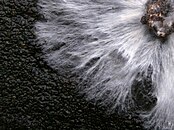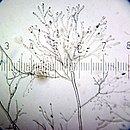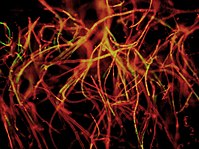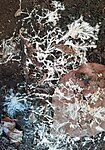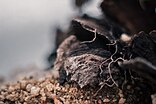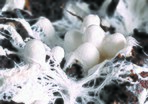
Back غزل فطري Arabic Miceliu AST Міцэлій Byelorussian Мицел Bulgarian Miseliom Breton Micelij BS Miceli Catalan مایسلیۆم CKB Mycelium Czech Mycelium Danish
Mycelium (pl.: mycelia)[a] is a root-like structure of a fungus consisting of a mass of branching, thread-like hyphae.[1] Its normal form is that of branched, slender, entangled, anastomosing, hyaline threads.[2] Fungal colonies composed of mycelium are found in and on soil and many other substrates. A typical single spore germinates into a monokaryotic mycelium,[1] which cannot reproduce sexually; when two compatible monokaryotic mycelia join and form a dikaryotic mycelium, that mycelium may form fruiting bodies such as mushrooms.[3] A mycelium may be minute, forming a colony that is too small to see, or may grow to span thousands of acres as in Armillaria.
Through the mycelium, a fungus absorbs nutrients from its environment. It does this in a two-stage process. First, the hyphae secrete enzymes onto or into the food source, which break down biological polymers into smaller units such as monomers. These monomers are then absorbed into the mycelium by facilitated diffusion and active transport.
Mycelia are vital in terrestrial and aquatic ecosystems for their role in the decomposition of plant material. They contribute to the organic fraction of soil, and their growth releases carbon dioxide back into the atmosphere (see carbon cycle). Ectomycorrhizal extramatrical mycelium, as well as the mycelium of arbuscular mycorrhizal fungi, increase the efficiency of water and nutrient absorption of most plants and confers resistance to some plant pathogens. Mycelium is an important food source for many soil invertebrates. They are vital to agriculture and are important to almost all species of plants, many species co-evolving with the fungi. Mycelium is a primary factor in some plants’ health, nutrient intake and growth, with mycelium being a major factor to plant fitness.
Networks of mycelia can transport water[4] and spikes of electrical potential.[5]
Sclerotia are compact or hard masses of mycelium.
Cite error: There are <ref group=lower-alpha> tags or {{efn}} templates on this page, but the references will not show without a {{reflist|group=lower-alpha}} template or {{notelist}} template (see the help page).
- ^ a b Fricker M, Boddy L, Bebber D (2007). Biology of the fungal cell. Springer. pp. 309–330.
- ^ "Fungi: Their Nature and Uses".
- ^ "Mycelium". Microbiology from A to Z. Micropia. Retrieved 30 November 2021.
- ^ Worrich A, Stryhanyuk H, Musat N, König S, Banitz T, Centler F, et al. (June 2017). "Mycelium-mediated transfer of water and nutrients stimulates bacterial activity in dry and oligotrophic environments". Nature Communications. 8: 15472. Bibcode:2017NatCo...815472W. doi:10.1038/ncomms15472. PMC 5467244. PMID 28589950.
- ^ Adamatzky A (April 2022). "Language of fungi derived from their electrical spiking activity". Royal Society Open Science. 9 (4): 211926. arXiv:2112.09907. Bibcode:2022RSOS....911926A. doi:10.1098/rsos.211926. PMC 8984380. PMID 35425630.
© MMXXIII Rich X Search. We shall prevail. All rights reserved. Rich X Search

